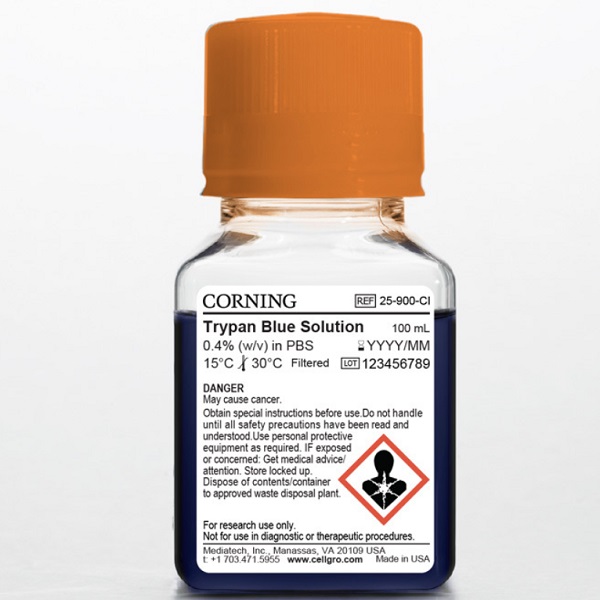Tetranatrium-3,3'-[(3,3'-dimethyl[1,1'-biphenyl]-4,4'-diyl)bis(azo)]bis[5-amino-4-hydroxynaphthalin-2,7-disulfonat] Chemische Eigenschaften,Einsatz,Produktion Methoden
R-S?tze Betriebsanweisung:
R45:Kann Krebs erzeugen.
R41:Gefahr ernster Augensch?den.
R37/38:Reizt die Atmungsorgane und die Haut.
R36/37/38:Reizt die Augen, die Atmungsorgane und die Haut.
R22:Gesundheitssch?dlich beim Verschlucken.
S-S?tze Betriebsanweisung:
S53:Exposition vermeiden - vor Gebrauch besondere Anweisungen einholen.
S45:Bei Unfall oder Unwohlsein sofort Arzt zuziehen (wenn m?glich, dieses Etikett vorzeigen).
S36/37/39:Bei der Arbeit geeignete Schutzkleidung,Schutzhandschuhe und Schutzbrille/Gesichtsschutz tragen.
S36:DE: Bei der Arbeit geeignete Schutzkleidung tragen.
S26:Bei Berührung mit den Augen sofort gründlich mit Wasser abspülen und Arzt konsultieren.
Chemische Eigenschaften
Trypan Blue is a dark Blue crystalline solid or powder that dissolves in water to form a blue solution. It's slightly soluble in soluble fiber yarn and doesn't dissolve in other organic solvents. When mixed with concentrated sulfuric acid, it turns dark greenish-blue, and when diluted, it becomes reddish-blue. With concentrated nitric acid, it creates a brownish-gray solution. In a 10% sulfuric acid solution, its aqueous solution turns red, while with sodium hydroxide, it becomes reddish-purple.

Definition
ChEBI: Trypan blue is an organosulfonate salt that is the tetrasodium salt of 3,3'-[(3,3'-dimethylbiphenyl-4,4'-diyl)didiazene-2,1-diyl]bis(5-amino-4-hydroxynaphthalene-2,7-disulfonic acid). It has a role as a histological dye, a fluorochrome and a carcinogenic agent. It is an organosulfonate salt and an organic sodium salt. It contains a trypan blue(4-).
synthetische
3,3′-Dimethylbenzidine double nitriding, in alkaline conditions and 4-Amino-5-hydroxynaphthalene-2,7-disulfonic acid(2 Moore) coupled.
Allgemeine Beschreibung
Bluish-gray to dark blue powder.
Air & Water Reaktionen
Azo dyes can be explosive when suspended in air at specific concentrations. Slightly soluble in water.
Reaktivit?t anzeigen
Direct Blue 14 is an azo compound. Azo, diazo, azido compounds can detonate. This applies in particular to organic azides that have been sensitized by the addition of metal salts or strong acids. Toxic gases are formed by mixing materials of this class with acids, aldehydes, amides, carbamates, cyanides, inorganic fluorides, halogenated organics, isocyanates, ketones, metals, nitrides, peroxides, phenols, epoxides, acyl halides, and strong oxidizing or reducing agents. Flammable gases are formed by mixing materials in this group with alkali metals. Explosive combination can occur with strong oxidizing agents, metal salts, peroxides, and sulfides. Direct Blue 14 is incompatible with strong oxidizing agents and strong acids.
Health Hazard
ACUTE/CHRONIC HAZARDS: Direct Blue 14 may cause irritation and may be absorbed through the skin. It is a positive animal carcinogen. When heated to decomposition Direct Blue 14 emits very toxic fumes of nitrogen oxides, sulfur oxides, carbon monoxide and carbon dioxide.
Brandgefahr
Flash point data for Direct Blue 14 are not available; however, Direct Blue 14 is probably combustible.
Sicherheitsprofil
Suspected carcinogen
with experimental carcinogenic,
neoplastigenic, and tumorigenic data. Poison
by intraperitoneal, intravenous, and
subcutaneous routes. Experimental
teratogenic and reproductive effects.
Mutation data reported. When heated to
decomposition it emits very toxic fumes of
NOx NazO, and SOx
m?gliche Exposition
Used in dyeing textiles; leather and
paper; as a biological stain.
Versand/Shipping
UN2811 Toxic solids, organic, n.o.s., Hazard
Class: 6.1; Labels: 6.1-Poisonous materials, Technical
Name Required. UN3143 dyes, solid, toxic, n.o.s. or dye
intermediates, solid, toxic, n.o.s., Hazard Class: 6.1;
Labels: 6.1-Poisonous materials, Technical Name Required.
Inkompatibilit?ten
Dust may form explosive mixture with
air. Trypan Blue is incompatible with strong oxidizing
agents. Incompatible with oxidizers (chlorates, nitrates,
peroxides, permanganates, perchlorates, chlorine, bromine,
fluorine, etc.); contact may cause fires or explosions. Keep
away from alkaline materials, strong bases, strong acids,
oxoacids, epoxides. Azo compounds can detonate. This
applies in particular to organic azides that have been sensitized
by the addition of metal salts or strong acids. Toxic
gases are formed by mixing materials of this class with
acids, aldehydes, amides, carbamates, cyanides, inorganic
fluorides, halogenated organics, isocyanates, ketones,
metals, nitrides, peroxides, phenols, epoxides, acylhalides,
and strong oxidizing or reducing agents. Flammable gases
are formed by mixing materials in this group with alkali
metals. Explosive combinations can occur with strong oxidizing
agents, metal salts, peroxides, and sulfides. Trypan
Blue is sensitive to prolonged exposure to heat.
Waste disposal
Consult with environmental
regulatory agencies for guidance on acceptable disposal
practices. Generators of waste containing this contaminant
(≥100 kg/mo) must conform with EPA regulations governing
storage, transportation, treatment, and waste
disposal.
Tetranatrium-3,3'-[(3,3'-dimethyl[1,1'-biphenyl]-4,4'-diyl)bis(azo)]bis[5-amino-4-hydroxynaphthalin-2,7-disulfonat] Upstream-Materialien And Downstream Produkte
Upstream-Materialien
Downstream Produkte

